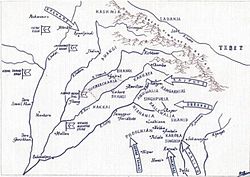Bhangi Misl
| Misls of the Sikh Confederacy |
|---|
 A 1780 map of the Punjab Region shows the relative positions of the Sikh Misls and other states. |
|
Phulkian Misl · Ahluwalia Misl · Bhangi Misl · Kanhaiya Misl · Ramgarhia Misl · Singhpuria Misl · Panjgarhia Misl · Nishanwalia Misl · Sukerchakia Misl · Dallewalia Misl · Nakai Misl · Shaheedan Misl |
The Bhangi Misl was a large Sikh Misl[1] headquartered in a village near Amritsar. It was founded in the early 18th century by Sardar Chhajja Singh,[1][2][3] who was baptised by Banda Singh Bahadur.[4][5] Bhangi Misl was comprised orthodox sikh with no violations against sikhism.
Expanse of Bhangi Misl[]
It grew in strength and territory to cover an area from Gujrat to Multan and emerged as the strongest power in the western Punjab region.[6] However, deaths among the leadership during the late 1760s reduced the Misl's power.[6]
Decline of power[]
The Bhangi misl engaged in numerous power struggles with the Sukerchakia Misl until they were severely weakened at the and the loss of Lahore to Ranjit Singh in 1799[7].[citation needed]
Bhangi Misl held the possession of Zamzama, the famous cannon, which was at the time named Bhangi Toap, Bhangianwala Toap and Bhangian di Top, names it retains to this day.[8]
References[]
- ^ a b Sikh History (2004). "The Bhangi Misal" Archived 4 March 2016 at the Wayback Machine, History of the Sikhs, 2004. Retrieved on 7 September 2016
- ^ Singh, Rishi (2015). State Formation and the Establishment of Non-Muslim Hegemony:Post-Mughal 19th-century Punjab. India: Sage Publications India Pvt Ltd, New Delhi, 23 April 2015. ISBN 9789351500759
- ^ Dhavan, Purnima (2011). When Sparrows Became Hawks: The Making of the Sikh Warrior Tradition, 1699-1799, p.60. OUP USA Publisher, 3 November 2011.
- ^ Jaspreet Kaur (2000). Sikh Ethos: Eighteenth Century Perspective, p.99. Vision & Venture, Patiala, 2000.
- ^ Jain, Harish (2003). The Making of Punjab, p. 201. Unistar Books Pvt. Ltd, Chandigarh.
- ^ a b McLeod, W. H. (2005). Historical dictionary of Sikhism. Rowman & Littlefield. p. 35. ISBN 978-0-8108-5088-0.
- ^ "Ranjit Singh | Maharaja, Biography, Family, & History | Britannica".
- ^ Singh, Khushwant A History of the Sikhs, Volume 1: 1469-1839. Oxford University Press, 2004, Page 198, Footnote 11
- Misls
- Cannabis and Sikhism
- Sikhism stubs